Struggling with inconsistent colors or weak plastic parts? Advanced masterbatches offer solutions, transforming your injection molding projects from basic to brilliant. It’s a real game-changer.
Advanced color masterbatches are concentrated mixtures of pigments or additives encapsulated in a carrier resin. They provide precise coloring, enhance material properties, and enable stunning special effects in injection molded products.
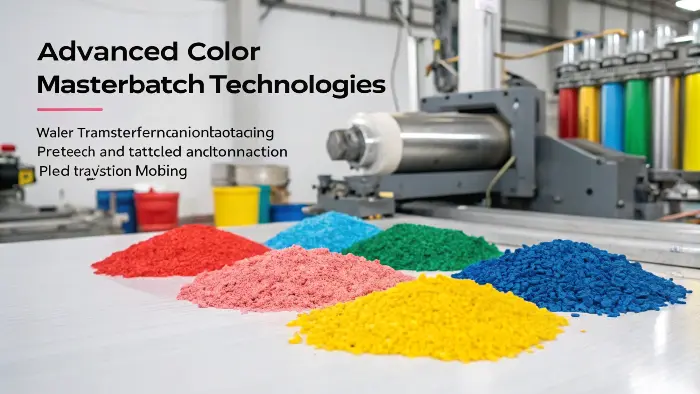
You know, when I first started in this industry, I thought color was just… color. Boy, was I wrong! The science and technology behind getting that perfect shade, or even adding cool effects, is pretty fascinating. If you’re like Alex, our project manager friend in Australia, always looking to optimize and innovate, then understanding masterbatches is key. So, let’s dive a bit deeper into what makes these tiny pellets so mighty, shall we? It’s more than just a splash of color, believe me.
What’s the Big Deal with Color Masterbatches in Injection Molding Anyway?
Ever wonder how plastic products get their vibrant, consistent colors? Masterbatches are the secret sauce, but their role goes far beyond just simple aesthetics. It’s pretty neat.
Color masterbatches are crucial in injection molding. They ensure uniform color distribution, improve processing efficiency, and can even add functional properties like UV resistance or flame retardancy to plastic parts.
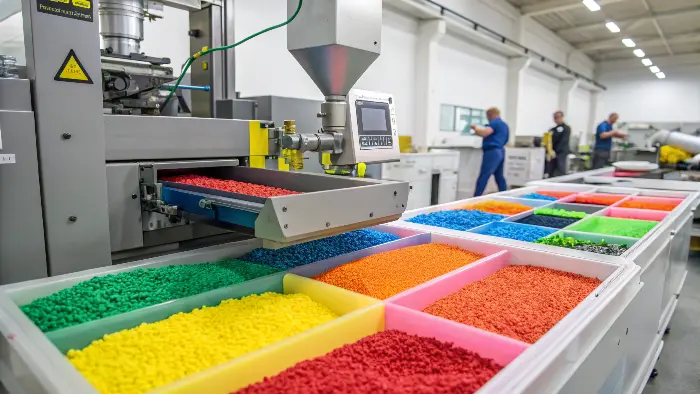
So, why are these little pellets such a big deal? Well, imagine trying to mix raw pigment powder directly into your plastic melt. It’d be a dusty, inconsistent mess! I remember one early project – disaster! Masterbatches solve this by pre-dispersing pigments or additives in a carrier resin. This means when you add them to your main plastic material, they mix in super evenly. Think of it like adding a concentrated coffee shot to milk versus trying to dissolve coffee grounds directly. The result? Consistent color from part to part, batch to batch. This is huge for someone like Alex, who needs every component in his consumer electronics to match perfectly. Plus, they’re easier to handle, cleaner, and often improve the processing stability of the plastic. And it’s not just about looking good. These masterbatches can carry functional additives. We’re talking about making plastics tougher, resistant to sunlight, or even flame retardant. So, yeah, they’re not just color; they’re a critical component for quality and performance. It’s a smart way to get a lot of bang for your buck. At CAVITYMOLD, we’ve seen firsthand how the right masterbatch can elevate a project from good to great.
Are All Masterbatches Created Equal for Different Molding Jobs?
Think one-size-fits-all for masterbatches? Not quite. Different applications and processes demand specialized formulations to achieve the best results. It’s all about the right fit.
No, masterbatches are tailored for specific uses and processing methods. This includes general-purpose, specialized for unique requirements, and functional masterbatches that add properties beyond color, like heat resistance.
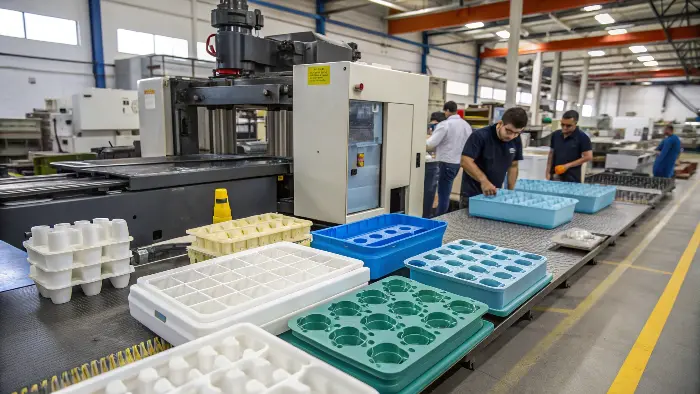
It’s a common misconception that any masterbatch will do. But trust me, as someone who’s seen projects go sideways because of the wrong choice, it really matters. Let’s break it down a bit.
First, you’ve got your masterbatches based on use:
- General Purpose: These are your workhorses. Good for a wide range of everyday plastic items where the demands aren’t super specific. Think basic containers or simple toys. I used to think these were "boring," but honestly, they’re the backbone for so many products.
- Specialized Masterbatches: Now we’re getting fancy. These are custom-made for particular jobs. For example, Alex might need a specific shade and texture for an automotive interior part that has to meet strict OEM standards. Or maybe it’s for an electronic housing that needs a precise, non-conductive color. These are engineered for performance in those niche areas. We once had a client needing a very specific, food-grade blue for baby products – that required a highly specialized masterbatch.
- Functional Masterbatches: These are the multi-taskers! They don’t just color; they add superpowers to your plastic. Need something to withstand the Aussie sun? UV resistant masterbatch. Making parts for an oven? Heat resistant. Worried about static build-up in electronics? Antistatic masterbatch. They can even make plastics flame retardant. It’s pretty amazing how much tech can be packed into these tiny pellets.
Then, there’s how they’re made for different processing methods: - Injection Molding Masterbatches: These are designed for the cut and thrust of injection molding. They need to disperse quickly and evenly under high pressure and temperature. There are even advanced versions for high-end products where perfection is key, and more standard ones for everyday items.
- Blow Molding Masterbatches: Think bottles and hollow parts. These need to ensure the color is vibrant and uniform, even when the plastic is stretched thin.
- Spinning Masterbatches: These are for textiles, coloring fibers as they’re being made.
So, you see, picking the right masterbatch isn’t just about color; it’s about the end-use, the plastic, and how you’re making the part. It’s a crucial decision point, and something we at CAVITYMOLD always discuss in detail with our clients.
Why Does Matching the Masterbatch Carrier to Your Plastic Actually Matter So Much?
Ever mixed oil and water? Using the wrong masterbatch carrier with your plastic can be just as problematic, leading to defects and headaches. Compatibility is king here.
The carrier resin in a masterbatch must be compatible with the main plastic resin. This ensures proper dispersion, consistent color, and maintains the mechanical properties of the final product.
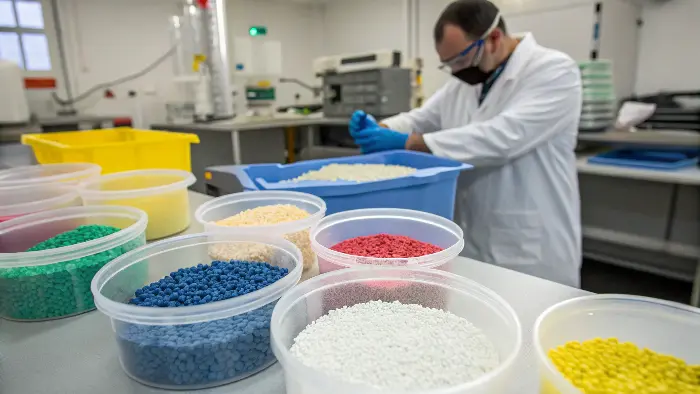
Okay, this is a big one, and something I learned the hard way early in my career. The carrier resin – that’s the plastic the pigment is mixed into to make the masterbatch pellet – has to get along with the main plastic you’re molding. Think of it like a friendship; if they don’t click, things get awkward. If the carrier isn’t compatible, the masterbatch won’t disperse properly. You’ll get streaks, specks, uneven color – basically, a reject part. And nobody wants that, especially not Alex who’s on a tight schedule for his consumer electronics. It can also mess with the physical properties of your final product. Imagine your super-strong part suddenly becoming brittle because the masterbatch carrier weakened the base resin. Nightmare! I recall a project where we were molding ABS parts, and someone mistakenly used a masterbatch with a PE carrier. The parts looked okay initially, but they failed impact testing spectacularly. Lesson learned!
So, masterbatches are often categorized by their carrier resin. You’ll see things like:
| Carrier Resin Type | Common Base Plastics Used With |
|---|---|
| PE Masterbatch | Polyethylene (LDPE, HDPE, LLDPE) |
| PP Masterbatch | Polypropylene (Homo, CoPo) |
| PVC Masterbatch | Polyvinyl Chloride |
| PS Masterbatch | Polystyrene (GPPS, HIPS) |
| ABS Masterbatch | Acrylonitrile Butadiene Styrene |
| EVA Masterbatch | Ethylene Vinyl Acetate |
| PC Masterbatch | Polycarbonate |
| PET Masterbatch | Polyethylene Terephthalate |
The rule of thumb is to use a masterbatch with a carrier that’s the same as, or highly compatible with, your bulk plastic. Sometimes, a "universal" carrier is marketed, but you’ve got to be extra careful and test thoroughly. For critical applications, I always, always recommend matching the carrier as closely as possible. It just saves so many potential problems down the line. It’s one of those details that seems small but has a massive impact on quality. At CAVITYMOLD, ensuring this compatibility is a standard part of our process consultation.
How Can You Go From Plain Jane Colors to Wow-Factor Special Effects with Masterbatches?
Tired of the same old solid colors? Special effect masterbatches can elevate your product’s appeal, adding textures, shimmers, and unique visual twists. It’s where art meets science.
Special effect masterbatches offer unique visual enhancements beyond standard colors. These include pearlescent, metallic, fluorescent, phosphorescent, glitter, and thermochromic effects, adding significant aesthetic and functional value.
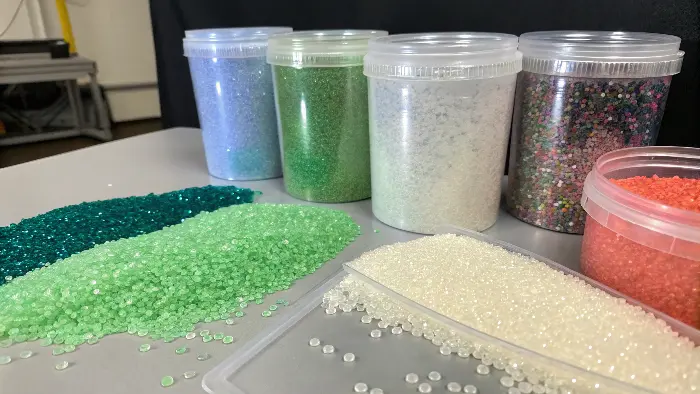
This is where things get really exciting for designers and product developers! Standard colors like your solid whites, blacks, reds, and blues are the bread and butter, absolutely essential for many applications and often for functional reasons too – like a black masterbatch with carbon black for UV protection. But what if you want your product to really pop? That’s where special effect masterbatches come into play. I remember working on a project for a high-end cosmetic line, and the client wanted packaging that screamed luxury. We used a pearlescent masterbatch from CAVITYMOLD’s specialty range, and wow – the subtle shimmer just took it to another level. The client was thrilled!
There’s a whole universe of effects you can achieve:
- Pearlescent: Gives that beautiful, lustrous sheen, like mother-of-pearl.
- Metallic: Creates a solid metallic look, from silver and gold to colored metallics. Super popular in automotive and electronics. Alex might use this for a premium feel on a new gadget.
- Fluorescent: These colors are incredibly bright and vibrant, almost glowing under normal light and intensely under UV light. Often used for safety products or eye-catching displays.
- Phosphorescent (Glow-in-the-Dark): Absorb light and then glow in the dark. Kids’ toys, safety signage – lots of cool uses.
- Glitter/Sparkle: Adds tiny reflective particles for a dazzling effect. We did a project for some festive decorations, and the sparkle effect was just perfect.
- Thermochromic: These are amazing – they change color with temperature! Imagine a coffee cup lid that changes color when the drink is hot, or a baby spoon that indicates if food is too warm.
- Photochromic: Change color when exposed to UV light, like some sunglasses lenses.
- Marble/Granite/Wood Effects: Mimic the look of natural materials, which can be fantastic for homewares or architectural components.
These aren’t just about looking pretty, though. Sometimes the effect has a function, like thermochromic indicators. But mostly, it’s about differentiation and adding perceived value. In a crowded market, a unique look can make all the difference. It’s a fantastic tool for designers to play with and for companies like CAVITYMOLD to help bring those visions to life. It does require careful processing, though, as some effect pigments can be a bit more sensitive to shear or temperature. But the results? Totally worth it.
Conclusion
Masterbatches are more than color; they’re key to performance, aesthetics, and innovation in injection molding. Choose wisely!
